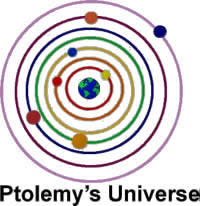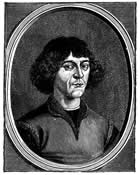The Scoop
This site is about the geology of New
Hampshire and how its landscape came to be. The geological history of
the Granite State will be explored starting from the beginning of the
Universe, about 14 billion years ago, and going right up to the
collapse of the Old Man in the Mountain on the night May 2 and the
early morning hours of May 3, 2003. Before we learn what geologists
have to say about our unique and very interesting geological history,
let’s review our place in the cosmos.
You Are Here
 We live on the planet Earth
that, along with the Moon, is circling our star, the Sun. Together with
the seven other planets (sorry, Pluto is now considered a "Dwarf
Planet" and a member of the Kuiper Belt), their moons and the countless
asteroids and comets, we make up the Solar System. The Sun is one star
out of hundreds of billions of stars arranged in a giant spiral shape,
we call the Milky Way Galaxy. Our galaxy
is accompanied by about 20 other galaxies, known as The Local Group, as
we travel through the Universe. Present
estimates place the number of galaxies in the known universe in the hundreds of
billions. Where did all these planets, stars and galaxies come from and
how long have they been around? We live on the planet Earth
that, along with the Moon, is circling our star, the Sun. Together with
the seven other planets (sorry, Pluto is now considered a "Dwarf
Planet" and a member of the Kuiper Belt), their moons and the countless
asteroids and comets, we make up the Solar System. The Sun is one star
out of hundreds of billions of stars arranged in a giant spiral shape,
we call the Milky Way Galaxy. Our galaxy
is accompanied by about 20 other galaxies, known as The Local Group, as
we travel through the Universe. Present
estimates place the number of galaxies in the known universe in the hundreds of
billions. Where did all these planets, stars and galaxies come from and
how long have they been around?
How to Start a Universe from
Scratch – The Big Bang Theory
Most astronomers
believe that the Big Bang Theory is the best current theory to
explain the creation of the Universe. According to the Big Bang Theory,
all matter and energy in the universe went from being confined to a
single point, to being nearly 14 billion light years across
(13.7 billion light years is the most recent estimate.)
Getting Larger Every Day
This matter and energy is now found in the
billions of galaxies that make up the known universe. The universe is
still getting larger as you read this. Most of the known galaxies are
flying away from each other and our galaxy at very high speeds. In
fact, the further away from us a galaxy is, the faster it is speeding
away. If this sounds pretty incredible to you, you are in good company.
Einstein himself was caught by surprise when it was found out that this
was going on.
The Joke is On the Joker
In a way, it is kind of funny
that we call this theory the “Big Bang”. The term “Big Bang” was
originally used by someone who thought the theory was ridiculous. His
effort to make the theory sound foolish didn’t work, and the name stuck.
| The Hubble Ultra Deep Field |
|
 This
image, taken by the Hubble Space Telescope, is among the deepest image of the
visible universe ever taken. These are some of the oldest galaxies ever
seen. These galaxies formed 13 billion years ago during what
astronomers call the "dark ages," the time shortly after the Big Bang. This
image, taken by the Hubble Space Telescope, is among the deepest image of the
visible universe ever taken. These are some of the oldest galaxies ever
seen. These galaxies formed 13 billion years ago during what
astronomers call the "dark ages," the time shortly after the Big Bang.
(Click
on the image for a closer look.)
Image Credit: S. Beckwith
& the HUDF
Working Group (STScI),
HST, ESA, NASA
|
A Likely Story
The universe is EVERYTHING that
exists, not just here on Earth, but EVERYWHERE in space. It’s hard to
believe that all of this stuff fit inside a single point at one time,
isn’t it? No one can blame you, but until you come up with a better
explanation of how the universe began, and back it up with supporting
evidence like this current theory has, we’ll stick with this one.
 This brings up a really
important point: theories are not rock solid explanations or proof of
anything, they are just the best explanation that fits all the evidence so
far. For example, it used to be thought that the Earth was the
center of the universe (and at the time this was the generally accepted
theory, scientists didn’t even know about our galaxy, let alone the
billions and billions of other galaxies that are out there). Their
“proof” for this theory existed in the apparent motion of all objects
in the sky: the Sun, Moon, planets and stars seeming to go around us
here on Earth. That’s pretty hard evidence to argue against, but today
we know this apparent motion is due to the real motions of the Earth; rotation
(spinning) about its axis and revolution
(orbiting) around the Sun. It is not because everything is going around
the Earth. This brings up a really
important point: theories are not rock solid explanations or proof of
anything, they are just the best explanation that fits all the evidence so
far. For example, it used to be thought that the Earth was the
center of the universe (and at the time this was the generally accepted
theory, scientists didn’t even know about our galaxy, let alone the
billions and billions of other galaxies that are out there). Their
“proof” for this theory existed in the apparent motion of all objects
in the sky: the Sun, Moon, planets and stars seeming to go around us
here on Earth. That’s pretty hard evidence to argue against, but today
we know this apparent motion is due to the real motions of the Earth; rotation
(spinning) about its axis and revolution
(orbiting) around the Sun. It is not because everything is going around
the Earth.
|
|
Is the Proof in the Pudding?
Did the original theory
provide "proof"?
No, but it was the best
explanation at the time.
Was the original theory a
"guess"?
Not entirely. It was, in part,
backed up by confirmed observations, otherwise known as facts. The same
arguments can be made today for the Big Bang Theory. So far, however,
it is holding up pretty well and has even had some predictions
confirmed.
| Claudius Ptolemy (ca. 100-170) |
|
 Ptolemy
was a Greek scientist and philosopher who lived and worked in
Alexandria, Egypt. He wrote books on astronomy, mathematics and
geography. Ptolemy
was a Greek scientist and philosopher who lived and worked in
Alexandria, Egypt. He wrote books on astronomy, mathematics and
geography.
Ptolemy theorized that the
Earth was the center of the universe and the Sun, Moon, stars and
planets revolved around us.
One of his
books, The Almagest, included a catalog of 1022 stars with
estimates of their brightness. The stars were organized into 48
constellations. Those 48 constellations formed the basis of today's
constellation system. There are now 88 constellations, Over the years,
scientists added new constellation from portions of the sky that
Ptolemy couldn't see from Egypt.
(Click
on the image for a closer look.)
|
| Nicolaus Copernicus (1473-1543)
|
|
 Nicolas
Copernicus was a Polish scientist and astronomer. He is best known for
his theory that the Sun is the center of the universe and the Earth,
Moon, planets and stars revolve around the Sun in a circular orbit.
This is known
as the heliocentric or sun-centered system. Nicolas
Copernicus was a Polish scientist and astronomer. He is best known for
his theory that the Sun is the center of the universe and the Earth,
Moon, planets and stars revolve around the Sun in a circular orbit.
This is known
as the heliocentric or sun-centered system.
(Click
on the image for a closer look.)
|
| Sir Isaac Newton (1642-1727) |
|
 Sir
Isaac Newton was an English mathematician and and physicist. He is the
inventor of calculus, came up with Newton's Law of Gravitation, which
describes the gravitational attraction between objects and states that
the gravitational attraction between objects is determined by the mass
of the objects and the distance between them. Newton's Law of
Gravitation is used to figure out the mass of objects and the
interactions between celestial bodies. Sir
Isaac Newton was an English mathematician and and physicist. He is the
inventor of calculus, came up with Newton's Law of Gravitation, which
describes the gravitational attraction between objects and states that
the gravitational attraction between objects is determined by the mass
of the objects and the distance between them. Newton's Law of
Gravitation is used to figure out the mass of objects and the
interactions between celestial bodies.
Newton also discovered the three laws of motion. The first law states
that an object at rest will stay at rest and an object in motion will
stay in motion - in a straight line - unless the object is acted upon by an outside force.
This is also know as the Law of Inertia. The second law states thatit takes a
force to move a mass and is represented by the mathematical statement that "f=ma" where "f" represents force, "m" represents mass that is multiplied by "a" which represents acceleration. The third law states that for
every action, there is an equal and opposite reaction.
(Click
on the image for a closer look.)
|
|